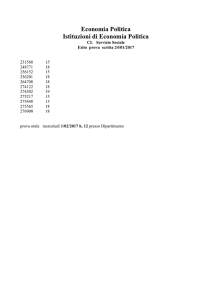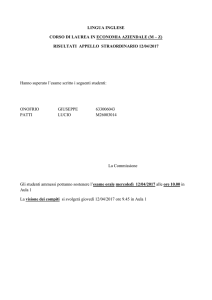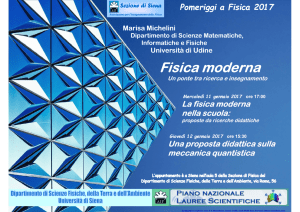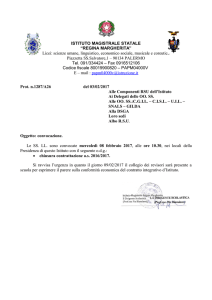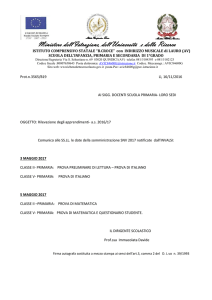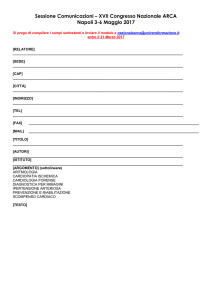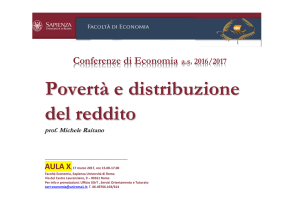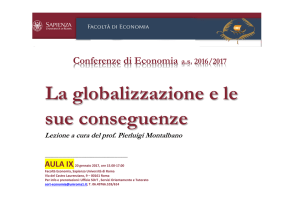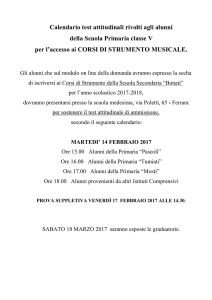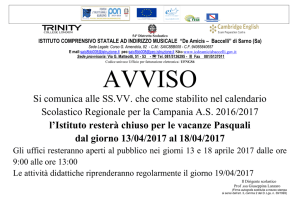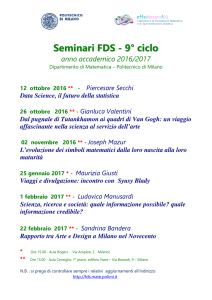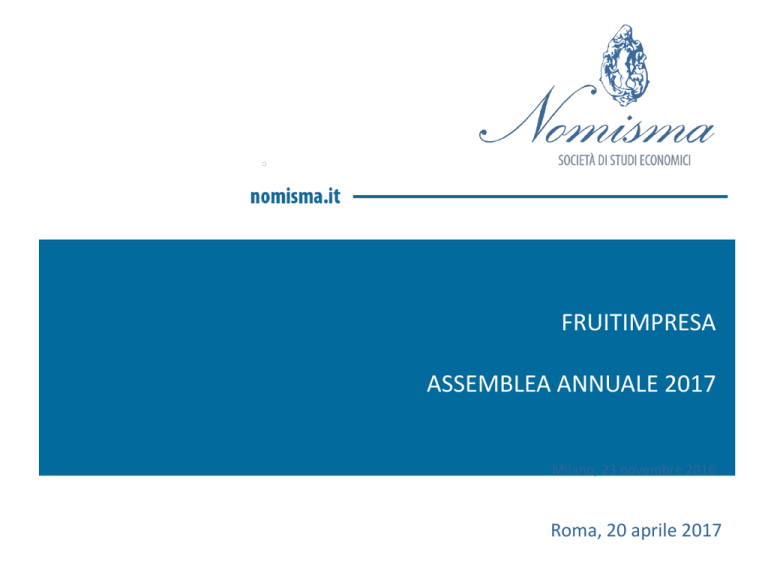
FRUITIMPRESA
ASSEMBLEA ANNUALE 2017
Milano, 23 novembre 2016
Roma, 20 aprile 2017
OUTLINE
Anche se il new global normal è meno
dinamico che i primi anni 2000 …
il 2017 si prospetta come un anno abbastanza
buono per l’Economia mondiale …
a dispetto dei rischi gro-strategici …
e delle minaccie di neo-protezionismo …
che potrebbero incidere pure sul commercio
internazionale di prodotti agricoli
IL NEW GLOBAL NORMAL
Crescita del PIL
CRESCITA DEL PIL - MONDO
2016
2017
2018
MONDO
3,0
3,3
3,6
STATI UNITI
1,6
2,4
2,8
GIAPPONE
1,0
1,2
0,8
CINA
6,7
6,5
6,3
AREA EURO
1,7
1,6
1,6
- Germania
1,8
1,8
1,7
- Francia
1,1
1,4
1,4
- Italia
1,0
1,0
1,0
REGNO UNITO
1,8
1,6
1,0
Fonte: Ocse
PREVISIONI RIVISTE GENERALMENTE AL RIALZO DA AUTUNNO
2017
(novembre
2016)
2017
(marzo)
2018
(novembre
2016)
2018
(marzo)
USA
2,3
2,4
3,0
2,8
Cina
6,4
6,5
6,1
6,3
Giappone
1,0
1,2
0,8
0,8
€ area
1,6
1,6
1,7
1,6
Germania
1,7
1,8
1,7
1,7
Francia
1,2
1,4
1,6
1,4
Italia
0,9
1,0
1,0
1,0
UK
1,2
1,6
1,0
1,0
India
7,6
7,3
7,7
7,7
Fonte: Ocse
CRITICITÀ
Stagnazione del commercio internazionale
• Integrazione produttiva
• Prezzi delle commodities
• Protezionismo
Bassi investimenti …
• In Cina, da +30% a marzo 2012 a +3% a fine 2016
• Dividendi mondiali inferiori che nel 2014
… malgrado alti debiti
‒ Emissioni $6.6tn nel 2016, battuto il record del 2006 …
Aumento dell’incertezza
• Politica (Brasile, Corea, Francia, Turchia)
• Policy (UK, US)
COME SI EREGGONO LE BARRIERE
Dazi
• Malgrado il WTO
• Regime differente per i PVS
Altre tasse
• IVA versus tassa sulle vendite
• Esenzione dell’IVA per l’export
Imposte sul reddito
• Companies currently deduct practically all of their costs, including imports, from their
sales revenue, and then pay taxes on the profits that are left.
• Border-adjusted tax, essentially involves ending the deductibility of imports so that
they would be taxed.
• At the same time, profits on exports would no longer be taxed, and the overall tax rate
would be cut.
Misure discriminatorie
• Sussidi
• bailouts
• Buy national
IVA + tariffa media
Fonti: World Trade Organization (tariffe); calcoli del New York Times; Deloitte Touche Tohmatsu (livello IVA); Tax
Foundation (U.S. sales tax average).
Trade-restrictive measures, excluding trade remedies
(average per month)
Fonte: WTO
WTO Committee on Agriculture (27 Marzo 2017)
Subsidies and market access in agriculture
• 29 questions
• 16 of these items being raised for the first time
US: farm subsidies notification
EU: domestic farm support, and price support for
livestock
India: price support programme for wheat, sugar cane
and crops
Canada: dairy policies
Switzerland: export subsidies (“Chocolate Law”)
‘HARD-POWER’ TRUMP BUDGET
LA TRUMPONOMICS E IL TURISMO AMERICANO
LE VULNERABILITÀ DELL’ECONOMIA CINESE
LE PROSPETTIVE PER L’ECONOMIA RUSSA
RUSSIA: COMMERCIO AGRICOLO
RUSSIA: COMMERCIO DI FRUTTA
IL BUSINESS CLIMATE IN EU E US
Fonte: inchiesta trimestrale Duke University–Grenoble École de Management
feb-01
ago-01
feb-02
ago-02
feb-03
ago-03
feb-04
ago-04
feb-05
ago-05
feb-06
ago-06
feb-07
ago-07
feb-08
ago-08
feb-09
ago-09
feb-10
ago-10
feb-11
ago-11
feb-12
ago-12
feb-13
ago-13
feb-14
ago-14
feb-15
ago-15
feb-16
ago-16
feb-17
INDICE €-COIN DELL’ANDAMENTO DELL’ATTIVITÀ
ECONOMICA NELL’AREA EURO
1,5
1,0
0,5
0,0
-0,5
-1,0
-1,5
Fonte: Banca d'Italia
EVOLUZIONE DELL’INFLAZIONE NELLA ZONA EURO
Fonte: Eurostat
PREZZO DELL’ENERGIA
Fonte: Eurostat
CRESCITA DEL PIL ITALIANO – IL TRIPLETE DELLE MAGLIE NERE
(ranking tra i G20, i G7 e gli EU15)
G20
G7
EU15
2008
19=
6=
15
2009
18
7
13
2010
20
7
12
2011
19
6
11
2012
20
7
15
2013
20
7
14=
2014
18
7
14
2015
18
7
13
2016
20
7
14
2017
19
7
15
2018
20
7
15
Fonti: Banca mondiale, World Development Indicators, accesso del 14 marzo 2017; Commissione Europea, Winter
2017 Economic Forecast, 13 febbraio 2017; “Economic and financial indicators”, The Economist, 11 marzo 2017
ITALIA – PRODOTTO INTERNO LORDO E SUE COMPONENTI
1,5
1,0
0,5
0,0
%
-0,5
-1,0
-1,5
-2,0
-2,5
Esportazioni nette
Investimenti fissi lordi
Consumi famiglie residenti
-3,0
-3,5
Variazione scorte
Consumi Pubblica Ammin.
PIL
T1 T2 T3 T4 T1 T2 T3 T4 T1 T2 T3 T4 T1 T2 T3 T4 T1 T2 T3 T4 T1 T2 T3 T4 T1 T2 T3 T4 T1 T2 T3 T4 T1 T2 T3 T4 T1 T2 T3 T4
2007
Fonte: Istat
2008
2009
2010
2011
2012
2013
2014
2015
2016
feb-08
mag-08
ago-08
nov-08
feb-09
mag-09
ago-09
nov-09
feb-10
mag-10
ago-10
nov-10
feb-11
mag-11
ago-11
nov-11
feb-12
mag-12
ago-12
nov-12
feb-13
mag-13
ago-13
nov-13
feb-14
mag-14
ago-14
nov-14
feb-15
mag-15
ago-15
nov-15
feb-16
mag-16
ago-16
nov-16
feb-17
Numeri indice (2010 = 100)
CLIMA DI FIDUCIA DEI CONSUMATORI
170
160
150
140
130
120
110
100
90
80
70
60
Personale
Fonte: Istat
Economico
Corrente
Futuro
FAMIGLIE CHE RIESCONO E NON RIESCONO A RISPARMIARE
50
Riescono a risparmiare abbastanza o qualcosa
45
Intaccano i risparmi e fanno debiti
40
35
25
20
15
10
5
Fonte: Istat
feb-17
dic-15
ott-14
ago-13
giu-12
apr-11
feb-10
dic-08
ott-07
ago-06
giu-05
apr-04
feb-03
dic-01
ott-00
ago-99
giu-98
apr-97
feb-96
dic-94
ott-93
ago-92
giu-91
apr-90
0
feb-89
%
30
ITALIA – CRESCITA DEL PIL
2017
2018
2019
Governo
1,1
1,2
1,2
Istat
0,9
..
..
Confindustria
0,8
1,0
..
Commissione europea
0,9
1,1
..
Fondo monetario internazionale
0,7
0,8
..
OCSE
1,0
1,0
..
The Economist
0,8
0,9
..
CRITICITÀ
Finanza pubblica
• Debito pubblico
• Procedura d’infrazione
Bassi investimenti dovuta all’incertezza su
• Crescita
• Stabilità politica
• Regole e loro applicazione
Bassa crescita della produttività
‒ Le star non sono pochissime
‒ Ma chi è in ritardo è lontano dalla frontiera (soprattutto servizi e
professioni)
‒ Poche competenze, a tutti i livelli
Infrastrutture e concorrenza
• La saga della legge “annuale”
• Il caso dell’AV

